Album Weeds – Ecuador
 1865-72. Medio Real, blue.
1865-72. Medio Real, blue.
Genuine
Lithographed, in slate-blue, and also in ultramarine, on thin, greyish-white wove paper. The sun’s face has several dots on it, but they cannot be said to resemble eyes, nose, and mouth, as, in all legible copies, there is merely a straight row of dots, touching each other, where the eyes would be, and two dots, very much to the left, where the nose ought to come. There are seventeen rays round the sun, including those which form part of the rainbow. The key-pattern is in four separate pieces, each piece containing five “keys”. The branch on the left side, between the oval and the flag, bears thirteen leaves. The right-hand flag has five white stripes on it, and the left-hand flag has four. The head of the axe shows very distinctly, projecting from the left-hand end of the fasces, below the central oval. The steamer in the oval has a large, dark flag flying from the left-hand mast. There are seventy pearls round the large circle; they are large, uniform in size and shape, and do not touch each other anywhere. The vertical lines of shading in the spandrels are very fine, and many of them run together, so that I have been unable to count them. Some copies of these stamps are very badly lithographed, so that the design can hardly be made out at all; this is more especially the case with those printed in slate-blue. Those printed in ultramarine, especially the dark shades, are usually much better executed.
Forged
Lithographed, in Prussian blue, on greasy-looking wove paper, which has a very strong shade of greenish-blue on the surface, showing more or less through the substance of the paper. The sun’s face bears regular eyes, nose, and mouth, which can easily be seen. There are twenty-eight rays round the sun. The key-pattern is very coarse, and there are only three ” keys ” in each piece. The branch on the left-hand side bears nine leaves only. The right-hand flag has five white stripes on it; the left- hand flag has five also. The fasces would hardly be recognized, and there is no axe-head to be seen projecting from the left-hand end. The steamer has no flag, and what ought to be the funnel appears like a palm tree with a dome-shaped head. There are 102 pearls round the large circle; they are very small, and some of them are pointed, instead of being round. The vertical lines of shading in the spandrels are very coarse, more especially on the left-hand, at the bottom.
Postmarks
Genuine.—1, 29, 38.
Forged.—1, with name, etc., in a straight line, in the center
 1865-72. Un Real, shades of yellow.
1865-72. Un Real, shades of yellow.
Genuine
Lithographed, in pale yellow, ochre-yellow, orange-yellow, or greenish-yellow, on greyish-white, or on bluish-white wove paper, also on quadrille paper, i.e., having laid lines, forming squares or oblongs. The large circle contains seventy-seven pearls, but they are not so large nor so regular as those of the MEDIO REAL. There are five “keys” in each of the four pieces of key-pattern, as in the genuine MEDIO REAL. The white lines forming this key- pattern, the crosses in the four corners, and the letters of both top and bottom inscriptions, are all of as nearly as possible the same width. There is a white stop before UN, and a similar one after REAL, and these two words do not anything like fill up the label which contains them. There are five white stripes on the right-hand flag, and four on the left-hand one, as in the genuine MEDIO REAL; and seventeen rays round the sun, including those which form part of the rainbow.
Forged
Very coarsely lithographed, in vermilion, on roughly-made, bluish-white wove paper. The large circle contains 108 pearls, very irregular in shape and size, and many of them running together. There are only three “keys” in each of the four pieces of key-pattern. The words ECUADOR CORREOS are in thin letters, like the genuine, but the bordering lines of the key-pattern are thicker than the lettering of the said words. The words UN REAL are thicker still, and the crosses in the corners are thickest of all; whereas, as I have pointed out, all these are of the same thickness in the genuine. I hope I have made it sufficiently clear that the above description has reference to the thickness or thinness of the white lines composing the said letters, key-pattern, and crosses. The words UN REAL fill up the label containing them, and there is no stop either before or after them. Each flag has five white stripes in it. I have only a very bad copy of this counterfeit, but there seem to be far more than seventeen rays round the sun, and they are blotched together a good deal. This forgery is not at all likely to prove dangerous; it is even coarser than the forged MEDIO REAL.
Postmarks
Genuine.—The genuine—at least all the copies which I have seen— bear a very singular cancellation, differing from any others with which I am acquainted. It consists of four concentric oblongs, with a very boldly zigzagged outline, and containing P. I., in large, outlined letters. I have six or eight copies of this UN REAL, yellow, in my collection, and they all, without exception, bear this postmark, the only variation being that one of them is struck in red, and all the others in black.
Forged.—54, without numerals; 62. It will be noticed that I have not described the genuine UN REAL so minutely as the MEDIO REAL ; but the colour is invariably so very faint that it is extremely difficult to make out any details at all. The forgery is a down-right vermilion, about the same shade as the normal hue of the 40 centimes of the French Republic of 1849.
1872. 1 Real, orange-yellow, and orange-vermilion.
Genuine
This stamp is an evident copy of the first Costa Rica set, but of very inferior execution, compared with those beautiful stamps. Lithographed on white wove paper, usually rather thin and soft (but I have one copy on quite stout paper); perforated 11. The condor’s neck is very thin, but not unnaturally so; it is about the same thickness as the upright stroke of the T in PORTE. The sun is set rather high up on the rainbow; that is to say, supposing the rainbow passed in front of the sun, instead of behind it, the lower part of the sun’s face would be hidden, and the upper third of it would appear above the rainbow. There are seventy-eight horizontal lines of shading, including the border-lines, counting down the right side of the stamp. The horizontal lines inside the scroll-work—that is to say, behind the condor, flags, and shield—are very close together, quite twice as close as the lines on the outer portion of the design. This is, perhaps, the best test of the genuine, for it can be very readily seen. The cross- strokes of the T and E of PORTE, and of the E and L of REAL, are very thin—much thinner than the vertical strokes of the said letters. The white outline of the little oval containing the figure I, at the top of the stamp, is perfect all round, and the top of this oval touches the fourth line from the top of the stamp, including the outer line. The two lines running round the whole stamp are very close together, so much so that there is not room for another line to be put between them. The white spot, representing the paddle-box, is in its proper place in the center of the hull of the steamer; the lower part of the funnel is dark, and the upper half is white. There is a very distinct cloud of steam or smoke coming tut of the funnel, and going to the right.
Forged
This is not at all a bad imitation, and I have no doubt it has taken in a good many unwary ones. Lithographed, in pale vermilion, on thin, yellowish-white wove paper: pin-pricked 12 1/2. The condor’s neck is unnaturally thick, being quite twice as thick as the upright stroke of the T of PORTE. The sun is set centrally on the rainbow; that is to say, supposing the rainbow were to pass in front of it, it would hide the center of the sun’s face, leaving a little bit of equal size showing both at the top and the bottom. There are only sixty-nine horizontal lines of shading in the general background of the stamp, counting down the right-hand side, and including the top and bottom lines. The horizontal lines inside the scroll-work, behind the condor, flags, shield, etc., are no closer together than the others, being, in fact, merely continuations of them. This is very easily seen, and will be a good test for this forgery. The cross-strokes of the T and E of PORTE, and the E and L of REAL, are the same thickness as the upright strokes of the said letters, except that the lower cross-stroke of the E of REAL is a little thinner than the rest. The white outline of the little oval containing the figure I, at the top of the stamp, is broken below, just above the word DEL; and it is placed too high up, so that it touches the third line from the top, counting the top line as one. The two lines running round the whole stamp are at some distance from each other, so that another line could easily be put between them. The white spot, representing the paddle-box, is too much to the left; the funnel is dark all the way up; and the cloud of steam or smoke appears to be issuing from the left-hand mast, instead of from the funnel.
Postmarks
Genuine.—I only possess one obliterated copy of the genuine, and it is cancelled with dots, which almost pierce the paper; but I cannot make out the form of the handstamp.
Forged.—The forgery is obliterated with 62. It must be borne in mind that this forgery is deceptive, not because it is so good, but rather because the genuine is so poor.
 1872. Un Peso, rose, carmine.
1872. Un Peso, rose, carmine.
Genuine
Typographed (?) in rose or carmine, on very white wove paper; perforated 11.
There is a good space of white between the rays of the sun and the border of the shield. The mountain-peaks have a sort of oblique snow-line marked upon them, and their points are rather higher than the smoke from the steamer. The front flags are shaded all over, except a very small portion, near the outer edge. The axe, in the lictor’s fasces, below the shield, has its head properly shaped. There are eighty-three square white dots round the circle. The inside of the u of UN is square at the bottom, and the inside of the O of PESO is nearly square. The point of the condor’s right wing, i.e., on the left-hand side of the stamp, does not touch the outline of the circle.
Forged
Very nicely lithographed, in carmine, on white wove paper, which shows very plainly the meshes of the wire gauze on which it was made; pin-perf. 12 1/2 and also 13. The upper rays of the sun almost touch the top of the shield. There is no oblique snow-line upon the mountain-peaks, and their summits are slightly lower than the smoke of the steamer. A large portion of the front flags is altogether unshaded. The head of the axe in the lictor’s fasces appears to be cleft in two. There are only sixty-eight square, white dots round the circle. The inside of the U of UN is rounded, and the inside of the O of PESO is very nearly round. The point of the condor’s right wing touches the circle, below the E of ECUADOR.
Postmarks
Genuine.—The genuine stamps usually bear a double circle, with name between the circles at the top, FRANCA at the bottom, and date, etc., in the center of the inner circle.
Forged.—The forgeries are cancelled with a rectangle, or a diamond, of square dots.
Reprints
The issues of 1865 and 1866, and the circular surcharge of 1897 here shown have all been reprinted. Full particulars will be found in Mr. Bacon’s Reprints. With regard to the 1865 issue, however, the MEDIO REAL and the UN REAL, in both colors, come within the scope of my book, as they differ in size from the genuine, and must therefore have been redrawn, which makes them forgeries, and not ordinary reprints. The genuine MEDIO REAL measures 19 x 22 mm., and the UN REAL measures 18 1/2 to 19 x 23 to 23 1/4 mm. In these soi-disant “reprints,” the MEDIO REAL measures 19 1/2 x 23 1/2 mm., and the UN REAL 20 to 20 1/4 x 24 1/4 mm. I have not seen these stamps myself, but have transcribed this information from Mr. Bacon’s book.
From: ‘Album Weeds’, 3rd edition by R. B. Eareé. 1906
 See also
See also

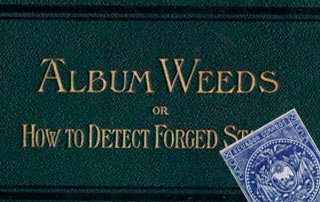
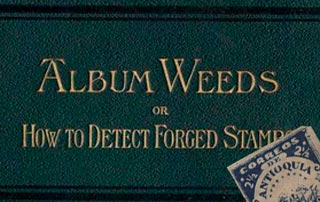
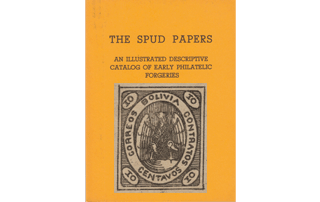

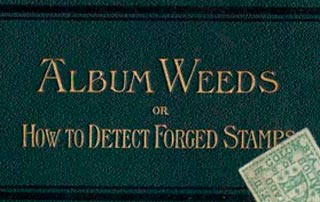
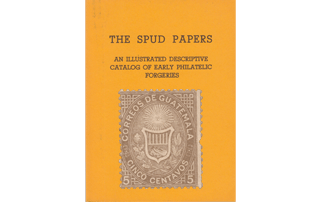


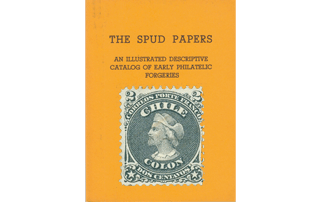
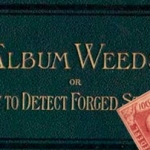
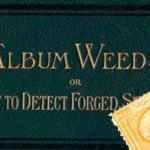
Leave a Reply
Want to join the discussion?Feel free to contribute!